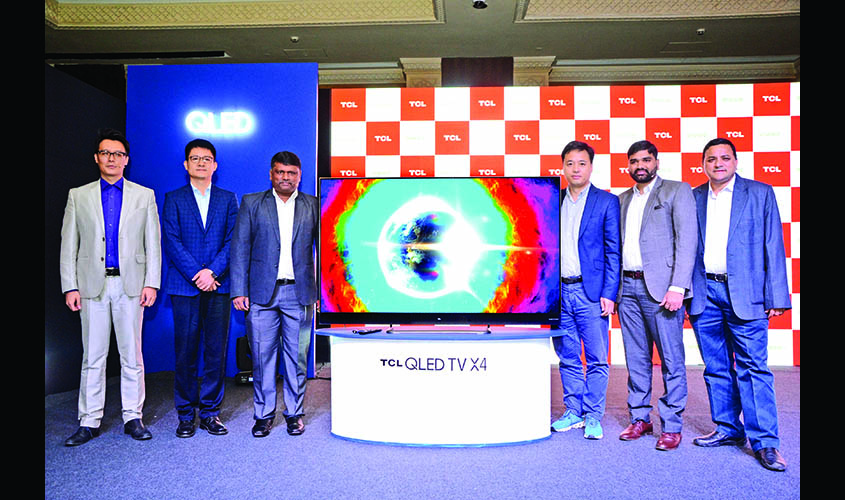Over the last few years, Chinese brands like OnePlus, Vivo and Oppo have managed to capture the global market for smartphones, overtaking old players like Apple, Motorola and Samsung. But can China’s dominance be extended to other consumer electronics goods? An increasing number of Chinese manufacturers are now looking to stake their claim on one of global technology’s most competitive segments, television. Shenzhen-based TCL Electronics is already emerging as one of the most successful smart TV brands in the world.
TCL is now preparing for the India launch of its Android QLED TV 65X4, which is being advertised as India’s first Google-certified television. Originally priced at Rs 1,49,990, this Android TV will be available from 25 October on Amazon at an introductory price of Rs 1,09,990. The brand has also announced another Google-certified smart TV, which is powered by Android 8.0 Oreo and equipped with AI Assistance, for its S6500 series.
The 65X4 is equipped with 4K UHD and HDR features that make for an immersive cinematic experience in a 3840×2160-pixel display. The highlight of this product, which includes Goggle Assistant and runs on Android 8.0 Oreo, is its voice search option that allows users to operate the TV with voice commands. A built-in Chromecast adds to the overall package. Users can play their favourite games, watch videos and use apps from their smartphones directly on the big HD screen.
It is not just great viewing experience that is being offered with this product. The sound has also been given special attention. A Harman Kardon speaker, audiophile grade, has been integrated with the TV set. These are supported by Dolby’s advanced DTS post-processing technology.
The central computing unit of the 65X4 is supported by a 64-bit quad-core processor and a 2.5GB RAM. There’s also the 16GB storage capacity that makes it easier for users to perform several tasks at the same time. The television will be available in three sizes—32,43 and 49 inch.
In conversation with Guardian 20, Mike Chen, country manager, TCL India, spoke about the brand’s positioning in the Indian TV market. According to him, India’s as-yet unsaturated TV market carries massive business potential for TCL. “This country has the third-largest TV market [in the world] and is home to more than one billion customers. What further makes it unique is that the business opportunity—particularly when it comes to smart consumer electronics—has not been fully realised the way it has been in other large markets such as Europe, China, and the US. But while the market is unsaturated at present, most trends point to a rapid evolution in consumer sensibilities towards cutting-edge, smart technology-powered devices. We intend to capitalise on this lucrative opportunity with our wide range of smart consumer electronics products.”
But for all the promises of the Indian market, it remains a challenging playfield for foreign manufacturers. “One of the biggest challenges in the Indian market is that of pricing. Some brands are still trying to differentiate themselves by following a price-driven marketing strategy, instead of focusing on technology. This puts pressure on other brands to price their products competitively, even if their products are technologically superior. The Indian smart TV market is also witnessing a rapid proliferation of brands, both indigenous and global. In the long run, this will make the market extremely crowded and ultra-competitive,” says Chen.
As they say in business studies, competition fosters innovation. This is especially true in the consumer electronics sector, where brand names and marketing strategies are secondary to the quality of the product being sold. Chen adds, “We address these market challenges through scale and innovation. Our extensive R&D expertise allows us to create state-of-the-art tech products designed for the future of home entertainment. Moreover, our global presence and distributed manufacturing capabilities enable us to streamline the cost of our manufacturing operations, thus significantly reducing the price of our end-user offerings. This helps us in delivering high-quality, cutting-edge smart entertainment solutions at extremely cost-effective prices and gives us a significant competitive advantage in the market.”
The brand is now interested in setting up manufacturing plants in India to get a stronger foothold on these shores and to further curtail manufacturing costs. “We aim to utilise the massive and growing talent pool to augment our global manufacturing operations through localised production. Doing so will also enable us to create several high-value jobs for the Indian workforce and actively contribute towards the government’s ‘Make in India’ campaign,” says Chen.

